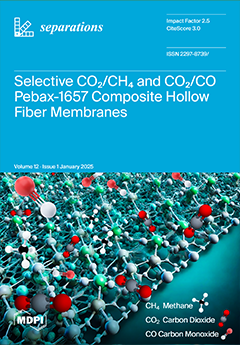Essential oils (EOs) have unique properties, such as antibacterial, antioxidant, and antiviral activities, which are beneficial in various industries, including cosmetics, food, and pharmaceuticals. In this study, the antioxidant and antimicrobial activities of
Pentacalia vaccinioides EOs obtained from leaves and flowers (fresh and
[...] Read more.
Essential oils (EOs) have unique properties, such as antibacterial, antioxidant, and antiviral activities, which are beneficial in various industries, including cosmetics, food, and pharmaceuticals. In this study, the antioxidant and antimicrobial activities of
Pentacalia vaccinioides EOs obtained from leaves and flowers (fresh and dried plant material) were evaluated using hydrodistillation (HD), steam distillation (SD), simultaneous distillation–extraction (SDE), and solid-phase microextraction (SPME) techniques. Antimicrobial activity (minimum inhibitory concentration, MIC) and antioxidant capacity (half-maximal inhibitory concentration, IC
50) were determined. The identification and quantification of the compounds present in the EOs were conducted by gas chromatography coupled to mass spectrometry (GC-MS). The main secondary metabolites identified in most samples obtained by different extraction techniques included phenol (~18%), 1S-α-pinene (~15%), β-phellandrene (~13%), β-pinene (~12%), 4-terpineol (~10%), γ-terpinene (~10%), trans-nerolidol (~8%), limonene (~8%), and β-thujene (~6%). EOs obtained by HD, SD, and SDE exhibited antioxidant activity, with IC
50 values between 621.7 and 696.6 µg/mL. Additionally, the EOs demonstrated bactericidal activity against
Bacillus subtilis and
Staphylococcus aureus, with MIC values of 5.0 and 45 µg/mL, respectively.
Escherichia coli and
Pseudomonas aeruginosa did not show antimicrobial susceptibility to EOs. This study constitutes the first evaluation of
Pentacalia vaccinioides EOs, demonstrating their bioactive potential and the relevance of the extraction method. The findings highlight this species as a promising source of natural compounds for therapeutic and preservative applications, depending on the type of plant material and extraction technique used. Future research should investigate how microclimatic conditions and plant development affect the chemical composition and elucidate the molecular mechanisms behind the observed bioactivities to better understand their cellular actions. Furthermore, the evaluation of the applications of EOs and hydrolates in the pharmaceutical and food industries, along with the exploration of the bioactive potential of extraction-derived hydrolates, offers a promising avenue to maximize plant utility.
Full article





